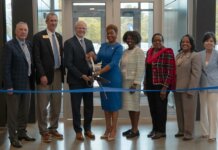
Alabama colleges’ science and math standouts, starting January 6, get a shot at paid internships in one of the most promising frontiers of science and industry.
The University of Alabama in Huntsville, for the third year, will administer a National Science Foundation program that places Alabama students in Alabama-based companies exploring the applications of the physics of low-temperature plasmas.
Arcane as it sounds, it’s a field that encompasses one of the four basic forms of matter — solid, liquid, gas and plasma.
Plasma is what the Big Bang and Broadway have in common. A highly excitable mix of elements less stable than a gas, plasmas expanded from the universe’s seed bomb to become the most plentiful form of matter. And one of its earliest applications was the neon that lit theater districts and bar tops.
Plasma TVs and computer screens are the most recognized recent applications — from the realm of low-temperature plasma, versus the relatively high-temperature plasmas, such as neon.
Low-temperature plasma research opens new frontiers from chemical and materials processing to environmental preservation, including water purification, nuclear reactor design, nano-materials, plasma jets for microscopic cutting, welding and coating and 3D nano-devices. Medical applications include super sanitization and microscopically thin artificial tissues.
But this emerging field depends on nurturing and supporting new generations of scientists and engineers involved in plasma science, and that’s the purpose of the UAH-administered internship program — called “Connecting the Plasma Universe to Plasma Technology in Alabama: The Science and Technology of Low-Temperature Plasma” (CPU2AL).
Beginning in January, undergraduate and graduate students in STEM fields from nine Alabama universities will be partnered with Alabama-based industries. It is one of four summer internship programs under a $20 million, five-year grant by the National Science Foundation.
“We set out to build a unique internship program that ties academia, particularly plasma physics in an academic setting, and bright students directly with industry,” says UAH’s Dr. Gary Zank, the program’s principal investigator. Zank is UAH’s director of the Center for Space Plasma and Aeronomic Research (CSPAR), the Aerojet Rocketdyne chair of the university’s Department of Space Science and a member of the National Academy of Sciences.
“This turned out far better than we anticipated, with excellent students interning with plasma-related companies that were largely unaware of the work being done in the plasma field by Alabama’s universities,” he says. “As a result, we’re building the national and international reputation of the state of Alabama as a premier region of both plasma-related research and plasma-related applications and industry.”
In its third year, the program is growing annually and is always searching for new industrial partners, Zank says.
For 10 weeks, industry partners get a student intern who has been selected in a competitive process and is among the top students who applied for the internship program.
“Generally speaking, the field of Low Temperature Plasma applications in Alabama is still rather small, that is why we are working on workforce development in the first place, to enhance the industry and research environment at the same time,” says Patrick Hambloch, project manager of the program. “We hope to expand our reach over the next few years and identify more companies that we can work with for future internship placements.”



